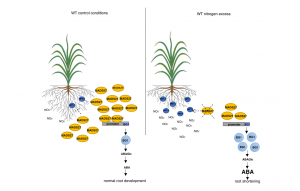Nitrogen (N) is an important element for plant growth and development. Although several studies have examined plants’ response to N deficiency, studies on plants’ response to excess N, which is common in fertilizer-based agrosystems, are limited. Therefore, the aim of this study was to examine the response of barley to excess N conditions, specifically the root response. The results of the study showed that Barley MADS27 transcription factor was mainly expressed in the roots and there was a significant decrease in MADS27 expression under excess N condition. Phenotypic analysis of root systems of wild type plants and constructed mutant plants revealed that MADS27 regulates barley root architecture under excess N stress. Further analysis revealed that MADS27 is a repressor of transcription and regulates the expression of BG1 β-glucosidase, which in turn regulates abscisic acid (ABA) level in roots. Overall, the findings of this study showed that MADS27 expression is downregulated in barley roots under excess N stress, which induces BG1 expression, leading to the release of ABA from ABA-glucose conjugate, and consequent shortening of the roots. This work was published in Frontiers in Plant Science DOI 10.3389/fpls.2022.950796.
Figure 2 MADS27 regulates barley roots response to excess N stress. MADS27 regulated barley root response under excess N stress. Increased N concentration in the rhizosphere activates N sensor and transporter NRT1.1, which provides N influx to the root cells. High N concentration downregulates the expression of MADS27, which relieves the inhibition of BG1 glucosidase expression. BG1 is activated and catalyzes the release of ABA from the ABA-glucose conjugate, which causes an increase in ABA levels and shortening of the barley roots.
